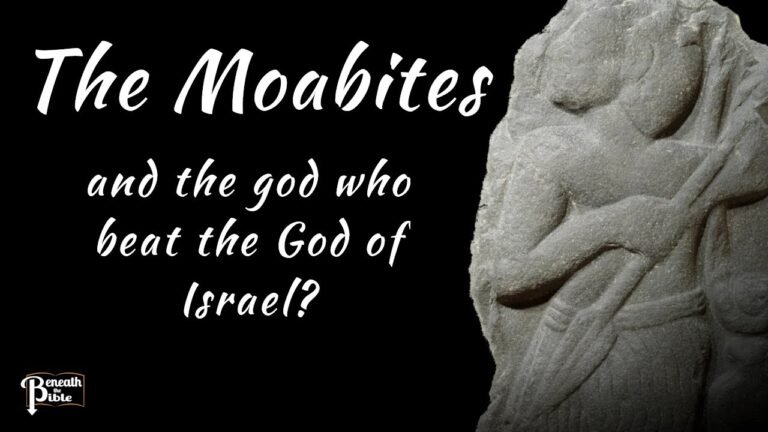Exploring Moab: Its Biblical Significance and Legacy
The ancient kingdom of Moab, nestled on the eastern shores of the Dead Sea, holds a significant yet often overlooked place in biblical history. Mentioned frequently throughout the Scriptures, Moab symbolizes both a nation and a complex relationship with Israel, marked by moments of conflict, alliance, and cultural exchange. From its origins as a descendant of Lot to its pivotal roles in various biblical narratives, understanding Moab in the Bible reveals deeper insights into the intricate tapestry of ancient Near Eastern history and the enduring themes of faith and struggle.
What was the reason for God’s curse on the Moabites?
The Moabites, along with the Ammonites, sought to undermine Israel’s journey to the Promised Land by hiring Balaam to pronounce a curse upon them. This act of betrayal, rooted in a lack of faith rather than ethnic identity, led to their exclusion from the Lord’s assembly, as outlined in Deuteronomy 23:3–4. Their desire to thwart God’s plan ultimately resulted in a divine curse that highlighted the consequences of faithlessness, reminding us that true rejection comes from the heart, not heritage.
What is the modern name for biblical Moab?
Moab, an ancient kingdom steeped in biblical history, is primarily located in the modern state of Jordan. This region, known for its rugged terrain, boasts stunning mountainous landscapes that have captured the imagination of many throughout the centuries. The geographical features of Moab not only provide a beautiful backdrop but also hold significant historical and cultural importance.
Today, the area that once comprised Moab extends along much of the eastern shore of the Dead Sea, a site recognized for both its natural beauty and its rich archaeological heritage. Visitors to this region can explore remnants of ancient civilizations, including impressive structures and artifacts that offer insights into the life and times of the Moabites. The convergence of history and nature makes this locale a fascinating destination for both tourists and scholars.
As modern Jordan embraces its ancient roots, Moab serves as a reminder of the region’s vibrant past. The enduring legacy of this biblical kingdom continues to influence the cultural landscape of Jordan, fostering a sense of pride among its inhabitants. With its breathtaking vistas and deep historical significance, the area invites exploration and reflection, bridging the ancient world with contemporary life.
What were the reasons behind God’s destruction of Moab?
The destruction of Moab serves as a poignant reminder of the complexities woven into the fabric of ancient relationships. As a nation closely related to Israel, the Moabites were not only neighbors but also rivals, primarily due to their pagan practices that stood in stark contrast to Israel’s monotheistic faith. This tension was exacerbated in the eighth century B.C. when Moab allied itself with Assyria, a formidable adversary of Israel, further sealing its fate in the eyes of God.
This alliance with Assyria did not go unnoticed, as it symbolized a rejection of God’s covenant with Israel and a willingness to embrace paganism. Consequently, Moab found itself facing divine judgment, reflecting the broader theme of accountability for turning away from God. The destruction of Moab serves as a stark warning of the consequences that arise from forsaking one’s spiritual heritage and aligning with those who oppose it.
Uncovering Ancient Stories in the Heart of Moab
Nestled in the stunning landscapes of Moab, the region is a treasure trove of ancient narratives waiting to be uncovered. From the striking red rock formations to the intricate petroglyphs etched into canyon walls, every corner of this desert oasis tells a story. These archaeological wonders offer a glimpse into the lives of early inhabitants who roamed the land, leaving behind clues of their existence and cultural practices that resonate through time.
As explorers traverse the rugged trails and hidden alcoves, they encounter remnants of a rich heritage that has shaped the identity of Moab. The enigmatic rock art, created by Indigenous peoples centuries ago, serves as a powerful reminder of their connection to the land and its resources. Each symbol and figure captures a moment in history, inviting visitors to reflect on the profound relationship between humanity and nature that has persisted across generations.
Engaging with these ancient stories fosters a deeper appreciation for Moab’s cultural significance and its role in the broader narrative of human history. Local guides and educational programs are dedicated to sharing this knowledge, ensuring that the lessons of the past are not forgotten. By immersing ourselves in these rich tales, we honor the legacy of those who came before us and inspire future generations to cherish and protect the landscapes that continue to captivate the world.
Moab: A Journey Through Faith and History
Nestled amidst the stunning red rock landscapes of Utah, Moab serves as a testament to the intertwining of faith and history. This enchanting town not only offers breathtaking vistas and outdoor adventures but also echoes the spiritual journeys of those who have come before. From ancient Native American petroglyphs to the early pioneers who carved their paths through the rugged terrain, Moab is a living canvas that captures the essence of human perseverance and divine inspiration.
Exploring Moab is akin to walking through a timeline of faith, where every canyon and cliff tells a story. Visitors can find solace in the majestic arches of Arches National Park, reflecting the awe-inspiring nature that has drawn seekers of truth for generations. As one delves deeper into the region’s rich heritage, it becomes clear that Moab is more than a destination—it’s a pilgrimage through the heart of history, inviting all to connect with the spiritual narratives that shaped this remarkable place.
The Sacred Heritage of Moab Revealed
Nestled among stunning red rock formations, Moab is a treasure trove of ancient history and cultural significance, revealing a sacred heritage that has captivated generations. This vibrant landscape, once home to Indigenous peoples, is adorned with petroglyphs and archaeological sites that tell stories of a rich past and spiritual connection to the land. Visitors can explore iconic sites like Arches and Canyonlands National Parks, where nature’s artistry intertwines with human history, inviting reflection and reverence. As the sun sets behind the mesas, the whispers of time echo through the canyons, reminding us of the enduring legacy and sacredness of this remarkable region.
The significance of Moab in the Bible extends beyond its geographical location; it serves as a powerful symbol of cultural interaction, conflict, and divine providence. The stories woven around this ancient kingdom highlight themes of redemption and faith, illustrating how even the most unlikely characters can play imprescindible roles in God’s overarching narrative. Understanding Moab’s biblical context enriches our appreciation of the scriptures and invites deeper reflection on the complexities of human relationships with the divine.







